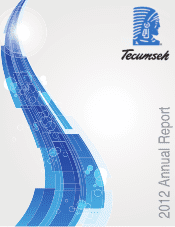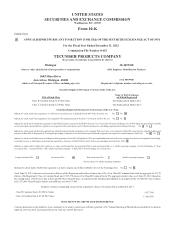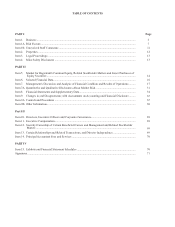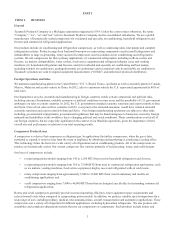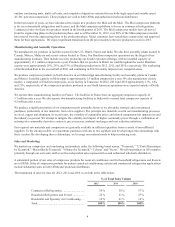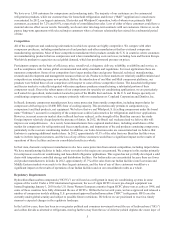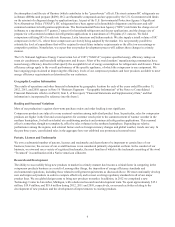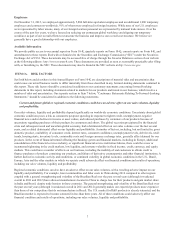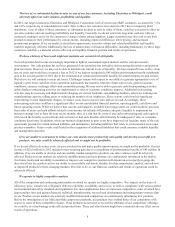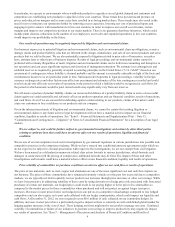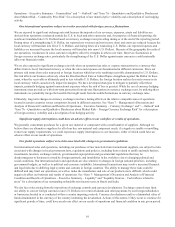Tecumseh Products 2012 Annual Report Download - page 6
Download and view the complete annual report
Please find page 6 of the 2012 Tecumseh Products annual report below. You can navigate through the pages in the report by either clicking on the pages listed below, or by using the keyword search tool below to find specific information within the annual report.5
We have over 1,500 customers for compressors and condensing units. The majority of our customers are for commercial
refrigeration products, while our customer base for household refrigeration and freezer (“R&F”) applications is much more
concentrated. In 2012, our largest customers, Electrolux and Whirlpool Corporation, both of whom were primarily R&F
customers, accounted for 7.2% and 6.6%, respectively of consolidated net sales. Loss of either of these customers could have a
material adverse effect on our results. Generally, we do not enter into long-term contracts with our customers. However, we do
pursue long-term agreements with selected major customers where a business relationship has existed for a substantial period
of time.
Competition
All of the compressor and condensing unit markets in which we operate are highly competitive. We compete with other
compressor producers, including manufacturers of end products and other manufacturers that have internal compressor
manufacturing operations. Most of these competitors manufacture their products outside the U.S. in countries where customers
are manufacturing products that use compressors and where manufacturing costs are lower, including Asia and Eastern Europe.
Worldwide productive capacities exceed global demand, which has put downward pressure on prices.
Participants compete on the basis of efficiency, price, sound level, refrigerant, delivery, reliability, availability and service, as
well as compliance with various global environmental and safety standards and regulations. For most applications there are
numerous competitors. Some of our competitors have larger product lines and greater financial, technical, manufacturing,
research and development and management resources than we do. Products in these markets are relatively undifferentiated and
competitors are introducing many new products. Before the introduction of our Mini and Midi compressor platforms, our
products were behind those of our competitors with respect to some of these competitive factors. The household refrigerator
and freezer market is vertically integrated with many appliance producers manufacturing a substantial portion of their
compressor needs. Due to the robust nature of our compressors for specialty air conditioning applications, we are particularly
well suited for specialized, niche markets located in parts of the Middle East and Asia. In the U.S. and Europe specialty air
conditioning compressor markets, we compete primarily with two manufacturers: Copeland Corporation and Danfoss, Inc.
In Brazil, domestic compressor manufacturers have some protection from outside competition, including import duties for
compressors delivering up to 18,000 BTU/hour of cooling capacity. This protection only pertains to components (e.g.,
compressors) and final products, not equipment. We believe that we and Whirlpool, S.A (selling compressors under the brand
name “Embraco”) account for a majority of the compressors sold in Latin America for refrigeration and freezer applications.
However, in recent years our market share in Brazil has been reduced, as the strength of the Brazilian currency has made
foreign imports relatively cheap despite the presence of duties. In 2012, the Brazil real weakened and we believe this will
improve our competitiveness. As a result, Asian manufacturers have captured market share, including small shares of the
market for compressors for refrigeration and freezer applications, and importation of the end products containing compressors,
particularly in the room air conditioning market. In addition, our Latin American sales are concentrated and we believe that
Embraco is capturing additional market share. In 2012, approximately 43.5% of the sales from our Brazilian facilities were
made to its three largest customers, and the loss of any of these customers would have a significant impact on the results of
operations of these facilities and on our consolidated results as a whole.
In East Asia, domestic compressor manufacturers also have some protection from outside competition, including import duties.
We have manufacturing facilities in India, where our sales in this region are concentrated. We compete in this market primarily
for compressors used in air conditioning and household refrigerator applications. This region has not yet fully developed a cold
chain with temperature-controlled storage and distribution facilities. Our Indian sales are concentrated because there are fewer
end product manufacturers in India. In 2012, approximately 47.7% of the sales from our Indian facilities into East Asian and
Middle Eastern markets were made to its three largest customers, and the loss of any of these customers would have a
significant impact on the results of operations of our Indian facilities and on our consolidated results as a whole.
Regulatory Requirements
Hydrochlorofluorocarbon compounds (“HCFCs”) are still used as a refrigerant in many air conditioning systems in some
regions of the world. Under a 1992 international agreement, the use of virgin HCFCs in new pre-charged equipment was
banned beginning January 1, 2010 in the U.S. Some Western European countries began HCFC phase-outs as early as 1998, and
some of these countries have fully eliminated the use of HCFCs. Within the last several years, we have approved and released a
number of compressor models utilizing U.S. government approved hydrofluorocarbon (“HFC”) refrigerants. HFCs are also
currently under global scrutiny and subject to possible future restrictions. We believe we are positioned to react in a timely
manner to expected changes in the regulatory landscape.
In the last few years, there has been an even greater political and consumer movement toward the use of hydrocarbons (“HCs”)
and carbon dioxide as alternative refrigerants, moving further away from the use of chlorine (which depletes the ozone layer of

